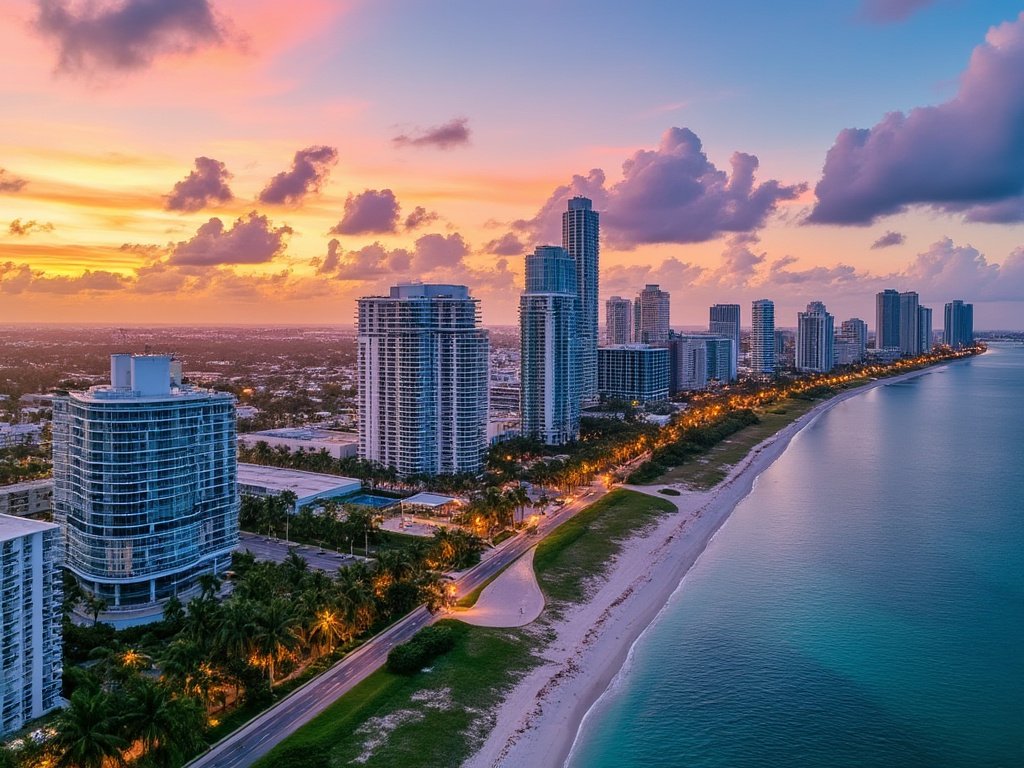Miami, a city often celebrated for its shimmering beaches, multicultural vibrancy, and booming tourism industry, is also a dynamic hub of growth, innovation, and ongoing challenges. Whether you’re a resident or a visitor, there’s always something happening in this fast-paced metropolis. From breaking developments in infrastructure and real estate to the latest in community initiatives and cultural happenings, Miami’s local news is as diverse as the people who call it home.
In this article, we explore some of the most significant trends shaping the city today: rapid real estate expansion, challenges in public transportation, environmental concerns, and the evolving arts and cultural landscape. We’ll also dive into some of the stories making headlines, providing you with a well-rounded snapshot of what’s happening in the Magic City.
1. The Real Estate Boom: Miami’s Skyline on the Rise
If there’s one thing that has defined Miami’s local news over the past decade, it’s the unrelenting rise of real estate development. From luxury high-rise condos to expansive mixed-use projects, Miami’s skyline has transformed dramatically, with cranes now a fixture of the cityscape.
In neighborhoods like Brickell and Edgewater, new towers are reaching ever higher, catering to a mix of affluent international buyers and locals seeking modern amenities with ocean views. These developments often come with a focus on high-end living, featuring luxury pools, state-of-the-art gyms, rooftop lounges, and even private marinas. But with this boom comes concerns about affordability, gentrification, and displacement, especially in historically lower-income areas like Little Haiti and Overtown.
Neighborhoods in Transition Miami’s neighborhoods are changing rapidly, with some areas experiencing unprecedented growth. Little River, once an overlooked section of the city, is now blossoming with boutique hotels, art galleries, and artisanal shops, attracting both entrepreneurs and investors. Similarly, Allapattah, known for its rich history and Dominican influence, has become a hot spot for development.
But these changes are not without controversy. Many residents, especially long-time homeowners and renters, are being priced out of their communities. The rising cost of living, combined with an influx of wealthy transplants from states like New York and California, has intensified the debate around affordable housing. Some city leaders are working to address this through zoning changes and affordable housing initiatives, but many believe more needs to be done to protect Miami’s diverse population from being pushed out of the urban core.
2. Public Transportation: A System Under Strain
While Miami’s real estate market is booming, its public transportation system has struggled to keep pace with the city’s growth. Miami-Dade County’s transit infrastructure, which includes buses, Metrorail, and Metromover, has long been criticized for being underfunded, inefficient, and outdated.
For a city with nearly half a million residents—and even more when counting the surrounding metropolitan area—traffic congestion remains one of the most significant frustrations for locals. Miami consistently ranks among the top cities in the U.S. for traffic delays, with commuters often spending over an hour traveling just a few miles during rush hour.
New Initiatives and Challenges Recent efforts have been made to improve public transit options, with local authorities proposing expansions to the Metrorail system and introducing new rapid bus transit routes. Additionally, Brightline, a high-speed rail service connecting Miami to Fort Lauderdale and West Palm Beach, has been a welcomed addition for commuters and tourists alike. There are even plans for an extension to Orlando, which could revolutionize travel within the state.
However, the system’s reliance on aging infrastructure, combined with years of underinvestment, has left many feeling skeptical about whether these changes will be enough to address the core issues. Funding remains a constant challenge, and while the county has expressed its desire to modernize transit, securing the necessary resources is easier said than done.
3. Environmental Concerns: A City on the Frontlines of Climate Change
As a coastal city with low-lying areas, Miami faces significant environmental challenges, with climate change and rising sea levels being among the most pressing. King tides, which flood streets in some of the city’s most popular neighborhoods like Miami Beach and Downtown, are no longer seasonal anomalies but regular occurrences. For local residents and business owners, this means living with the constant threat of flooding, even on sunny days.
Resilience and Sustainability Efforts In response, Miami has become a leader in climate resilience planning. The city has invested millions in infrastructure upgrades, including pumping stations, raising roads, and improving drainage systems. Miami-Dade County has also launched initiatives to encourage sustainable development practices, urging developers to incorporate flood-resistant designs and green building standards into their projects.
Moreover, the city is pushing forward with the Miami Forever Bond, a $400 million bond program designed to fund resiliency projects, including flood control and shoreline protection. But while these initiatives are a step in the right direction, critics argue that they may not be enough to fully safeguard the city from the inevitable impacts of climate change. Some question whether Miami’s continued real estate expansion in vulnerable coastal zones is a sustainable long-term strategy.
The Everglades and Biscayne Bay Environmental concerns also extend beyond rising sea levels. The ongoing battle to protect the Everglades—one of the world’s most unique ecosystems—is a central issue in Miami’s environmental discourse. The Everglades not only provide critical water resources to the region but also serve as a natural buffer against storms and flooding. Conservation efforts are constantly at odds with development pressures, and the health of the Everglades remains a top concern for environmentalists.
Meanwhile, Biscayne Bay, a natural gem that draws both locals and tourists alike, is suffering from pollution and habitat degradation. Fish kills and algae blooms have become increasingly frequent, leading to urgent calls for stricter water quality standards and restoration efforts. Miami’s environmental future hinges on the ability to strike a balance between development and preservation.
4. Arts and Culture: A Flourishing Scene with Global Appeal
Miami’s cultural scene is thriving, attracting international attention and solidifying its reputation as a global arts hub. Home to world-renowned events like Art Basel Miami Beach, the city has become a beacon for artists, galleries, and collectors. This annual event alone brings in hundreds of thousands of visitors from around the world, making it one of the most significant art fairs in the Americas.
But beyond the high-profile events, Miami’s cultural fabric is woven from the creativity of its local artists, musicians, and performers. Neighborhoods like Wynwood, once a forgotten industrial district, are now at the forefront of the city’s artistic expression. Wynwood’s iconic street murals and eclectic galleries draw crowds year-round, creating a vibrant public space where art can be both seen and experienced.
The Rise of Local Talent In recent years, Miami’s cultural institutions have also stepped up to showcase homegrown talent. The Pérez Art Museum Miami (PAMM) and the Museum of Contemporary Art (MOCA) have hosted exhibitions featuring emerging and established artists from the region, bringing greater attention to Miami’s diverse artistic voices. Additionally, the Little Haiti Cultural Complex and the African Heritage Cultural Arts Center provide important platforms for underrepresented communities, ensuring that Miami’s cultural scene remains as diverse as its population.
Performing Arts and Music Miami is also making its mark in the performing arts, with venues like the Adrienne Arsht Center for the Performing Arts hosting everything from Broadway shows to symphony performances. The city’s music scene, which has long been a powerhouse in the Latin music world, continues to evolve, with genres like reggaeton, salsa, and Latin trap influencing the global music industry. The annual Calle Ocho Music Festival in Little Havana remains a vibrant celebration of Miami’s Cuban heritage and a testament to the city’s love for live music.
5. Crime, Policing, and Public Safety: A Community in Transition
While Miami enjoys the reputation of being a cosmopolitan paradise, it’s not immune to challenges related to crime and public safety. The city has made significant strides in reducing violent crime over the past decade, but issues such as drug trafficking, gun violence, and gang activity continue to pose challenges in certain areas.
In neighborhoods like Liberty City and Little Havana, community leaders and law enforcement are working together to address these concerns through community policing initiatives and youth outreach programs. There is a growing recognition that public safety isn’t just about enforcement but also about addressing the root causes of crime, such as poverty, lack of opportunity, and systemic inequality.
Police Reform and Accountability In the wake of national debates about police reform, Miami has taken steps to improve transparency and accountability within its police force. The implementation of body cameras, increased training for officers, and efforts to build stronger relationships with the community are all part of an ongoing push for reform. However, the city has also faced criticism for instances of police misconduct and the handling of protests, particularly during the racial justice demonstrations of 2020.
Looking ahead, Miami’s approach to public safety will likely continue to evolve, with an emphasis on community engagement, crime prevention, and ensuring that all residents feel protected.
A City of Opportunity and Challenge
Miami’s local news is a reflection of a city in constant motion—where opportunities abound, but challenges persist. Whether it’s the booming real estate market, the fight for affordable housing, the push for environmental resilience, or the thriving arts scene, Miami is a place where innovation and tradition collide.
As the city continues to grow and evolve, one thing remains certain: Miami will always be a city with its eyes on the future, ready to face the challenges of today while embracing the opportunities of tomorrow.





